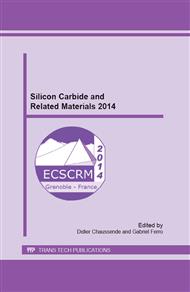[1]
A-O. Konstantinov, Q. Wahab, N. Nordell and U. Lindefelt, Materials Science Forum, vols. 264-268, 513 (1998).
DOI: 10.4028/www.scientific.net/msf.264-268.513
Google Scholar
[2]
R. Raghunathan and B-J. Baliga, Solid State Electronics, vol. 43, 199 (1999).
Google Scholar
[3]
D-M. Nguyen, C. Raynaud, M. Lazar, G. Pâques, S. Scharnholz, N. Dheilly, D. Tournier and D. Planson, Materials Science Forum, vols. 717-720, 545 (2012).
DOI: 10.4028/www.scientific.net/msf.717-720.545
Google Scholar
[4]
W. Loh, B. K. Ng, J. S. Ng, S. I. Soloviev, H. Y. Cha, P. M. Sandvik, C. M. Johnson and J. P. R David, IEEE Transactions on electron devices, vol. 55, no. 8 (2008).
DOI: 10.1109/ted.2008.926679
Google Scholar
[5]
T. Hatakeyama, T. Watanabe, T. Shinohe, K. Kojima, K. Arai, and N. Sano, Applied Physics Letters, vol. 85, n°. 8, pp.1380-1382, (2004).
DOI: 10.1063/1.1784520
Google Scholar
[6]
T. Flohr and R. Helbig, Journal of Applied physics, vol. 66, no. 7, p.3060 (1989).
Google Scholar
[7]
H. Hamad, P. Bevilacqua, C. Raynaud and D. Planson, 10th Conference on Ph. D. Research In Microelectronics and Electronics PRIME, (2014).
DOI: 10.1109/prime.2014.6872761
Google Scholar
[8]
P. A. Wolff, Physical Review, vol. 95, no. 6, p.1415 (1954).
Google Scholar
[9]
W. Shockley, Solid State Electronics, vol. 2, no. 1, p.35 (1961).
Google Scholar
[10]
A. G. Chynoweth, Journal of Applied Physics, vol. 31, no. 7, p.1161 (1960).
Google Scholar
[11]
C. Raynaud, D-M. Nguyen, N. Dheilly, D. Tournier, P. Brosselard, M. Lazar and D. Planson. Physica status solidi A, vol. 206, n°10 (2009) pp.2273-2283.
DOI: 10.1002/pssa.200825183
Google Scholar
[12]
M. Lazar, F. Jomard, D-M. Nguyen, C. Raynaud, G. Pâques, S. Scharnholz, D. Tournier, D. Planson, Materials Science Forum, vols. 717-720, 885 (2012).
DOI: 10.4028/www.scientific.net/msf.717-720.885
Google Scholar
[13]
C. A. Lee R. A. Logan, R. L. Batdorf, J. J. Kleimack and W. Wiegmann, Physical Review, vol. 134, p. A761 (1964).
DOI: 10.1103/physrev.134.a761
Google Scholar
[14]
C. R. Crowell and S. M. Sze, Applied physics letter, vol. 9, p.242 (1966).
Google Scholar
[15]
H. Niwa, J. Suda and T. Kimoto, Materials Science Forum, vol 778-780, p.461 (2014).
Google Scholar


